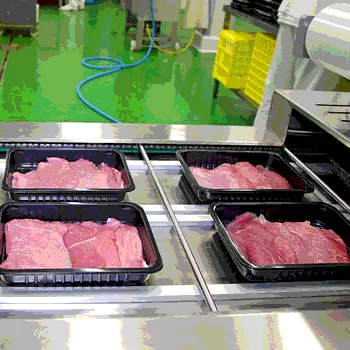Food Safety of Packaging Equipment: A Closer Look

Food safety remains the central packaging supply chain concern among food professionals and suppliers because packaging plays a critical role in keeping food safe. Package delivery systems need to ensure the product stays safe through the supply chain and adheres to standards and specs throughout the entire chain, from inception to store.
Product inspection technology improves food safety while enhancing efficiency, and recent strides help manufacturers keep cost in alignment with capability contributing to sustained growth in the technology. The inspecting, detecting, and checkweighing machinery category is projected to continue expanding from a reported $438 million in 2017, at a projected 8.6 percent annual rate of growth, according to the 2018 State of the Industry U.S. Packaging Machinery Report produced by PMMI, The Association for Packaging and Processing Technologies.
Today’s food manufacturers must inspect every item on their lines whereas previous conventions may have only required checking for proper labeling. Inspection and detection solutions now deliver more than a just single piece of information with systems providing comprehensive and precise observations. Inspection equipment allows manufacturers to detect multiple irregularities with greater precision and speed, and invites opportunities for cost savings. At the beginning of the supply chain, processors stand to reduce the waste that accumulates from a defective product. Throughout the line, these solutions are designed to reduce the downtime stemming from stoppages and fixes required in the event of a malfunction. At the end of the line, brands can better avoid damaging hits to their reputation by lowering, or preventing, the risk of recalls.
New advances in X-ray inspection technologies are helping the food industry identify contaminants during manufacturing. Such technologies include sensors that are capable of detecting ultra-small, nonmetallic contaminants, including bones. The meat industry, for example, can reduce the risk of bone making its way into the final product, especially poultry processors that must combat a higher threat of this occurrence due to the thinness of the rib and fan bones. Upgraded X-ray systems produce higher-quality images and can find contaminants within products with overlapping pieces, such as fries, frozen vegetables, or chicken nuggets.
Developed initially for detecting foreign materials in products, such as glass, metal, and plastic, X-ray technologies now offer consumer packaged goods companies detailed information about the product. The inspection equipment has become more sensitive and can deliver a broader scope of information—from examining the shape and edges of a food product to revealing density and volume. In addition, the latest inspection and detection equipment can detect count, missing or broken items, shape, and position. Systems can inspect products in various packaging formats as well, such as cartons, boxes, plastic containers, standard film wrapping, foil or metalized film, and pouches.
Also, original equipment manufacturers (OEMs) have increased the sensitivity of the detectors. In the past, the power necessary to operate the equipment required cooling during its operation. Now that the power is pointedly less, there is no need for cooling, consuming less energy during usage. Due to the sensitivity of the detectors, there’s an abundance of new information to garner that can help companies build protocols for efficiency into their operations.
Robotics Now Permitted to Pitch In
Because of strict health and safety regulations, robotics were fraught with limitations in the food and beverage industry and restricted to certain tertiary and some secondary packaging tasks. Often, robots were only at the end of the line, serving palletizing functions since they didn’t meet necessary standards for direct contact with food. OEMs continue to develop robots with a high protection class suitable for handling unpacked goods and subsequent washdown, creating new opportunities for the direct and indirect handling of foods.
The Food Safety Modernization Act (FSMA) of 2011, which focuses on the prevention of food contamination, has created some impetus for the introduction of robots. The U.S. Centers for Disease Control and Prevention reports that upwards of 48 million foodborne illnesses occur annually in the United States, with an estimated one in six people affected by a food-related illness. Regulations like FSMA are intended to reduce the rates these illnesses. To increase output and develop new products, food and beverage machinery OEMs are shifting towards industrialized equipment, moving from manual to mechanical food processing, resulting in strong growth in the market for food and beverage processing and packaging machinery.
Food safety is essential in protecting consumer health. Manufacturers of equipment need to adhere to all safety standards, and, in North America, Section 204 (Enhanced Tracking and Tracing of Food and Recordkeeping) of FSMA requires businesses to be able to, as a minimum, identify the immediate supplier and recipient (other than retailers to consumers) of a product.
In addition, the integration of vision systems, along with rapid developments in artificial intelligence and deep learning is creating opportunities to better automate quality control of products. Cameras can be used to monitor attributes, such as size, shape, and color, and identify deviation from acceptable parameters
Manufacturers and users accept that this increase in machine complexity results in an increase in prices as control components, for example, programmable logic controllers, servo motors, and computers, have to be incorporated. Additional benefits further justify the cost increase, including increased flexibility and improved safety functions, real-time monitoring, machine vision inspection, data collection, and above all, machine-to-machine communication. This last benefit is of vital importance as users respond to Industrial Internet of Things and Industry 4.0 trends, which have become topical but are part of the increasing need to connect machines on the factory floor with the enterprise level.
Sean Riley is the senior director, media and industry communications, PMMI, which hosts PACK EXPO Las Vegas and Healthcare Packaging EXPO (Sept. 23–25, 2019). For more information and to register online, visit packexpolasvegas.com.
Looking for quick answers on food safety topics?
Try Ask FSM, our new smart AI search tool.
Ask FSM →






